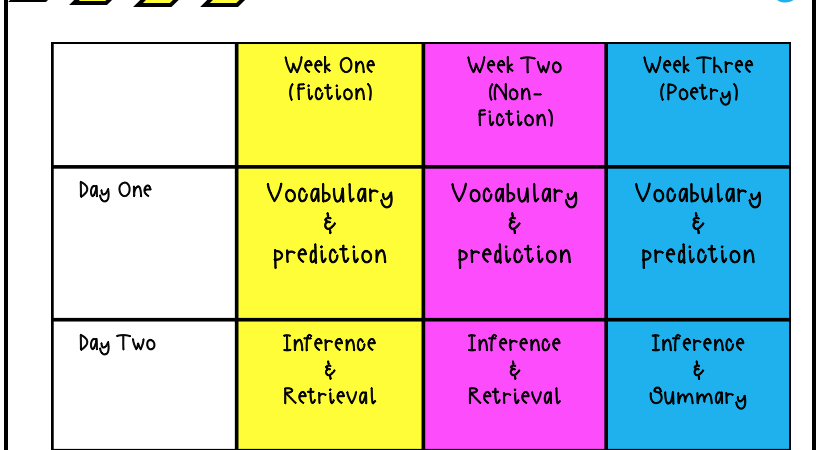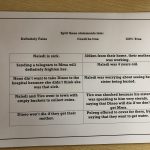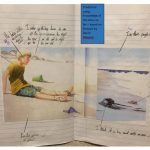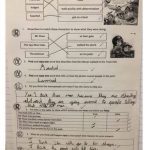As the title suggests, I’m making a start at teaching Whole Class Guided Reading, having read many different blog posts and articles on this strategy. To be perfectly honest, I was never a big fan of “The Carousel” for Guided Reading, as I found most of the children weren’t actually reading or improving their reading in any which way. More often than not, they were improving their writing skills, which completely defeats the purpose. I was inspired to try this approach having read this blog, incorporating Reading VIPERS, which I’ve discussed at length on my Instagram and previous post. This blog post will outline how I approach Whole Class Guided Reading and I hope to give some of you some ideas or samples to try! Teaching is all about adapting and being flexible, right?
See this post for tips on how to convert to Whole Class Guided Reading!
Planning
The dreaded word. If you’re taking the plunge to start Whole Class Guided Reading, you need to do it properly to make sure the lessons are:
- Purposeful
- Based on Reading Skills
- Aim to improve children’s reading with each session.
- We’ve all sat there with groups of children and come up with questions on the spot. Unless you’ve planned which Reading Skill this is explicitly teaching, you’re wasting your (and the children’s) time. I use Reading VIPERS to plan my Whole Class Guided Reading sessions, and take a different aspect per Guided Reading sessions. My timetable looks a little bit like this.

I take some aspects together as I’m not lucky enough to have a Guided Reading slot each day. But also, some of these aspects work when taught together. Below I have attached a planning template in which I use to plan my lessons. This keeps my sessions focused, skills based and purposeful. It also takes time out of planning, which let’s face it, most of us dislike! When planning for guided reading, focus explicitly on the skill and ensure that your activity will teach and extend children on this aspect of reading.
Teaching
As you can see in the planning template above, I spend 10 minutes on the actual reading of a text or extract. This can be the teacher reading, or an individual child, or the class as a chorus, echo reading, group reading, it’s up to you! But either way, 10 minutes is all that should be spent on the reading part. Following this, I’ll ask children 3 Quick Fire Questions! In our class, this basically means, I’ll ask 3 simple retrieval questions and allow the children to discuss in groups. This will allow me to check if they have understood the text at a basic level, as well as working on retrieval skills daily. If they cannot answer these questions, the text/extract is too difficult for them.
I always insist on the children using a ruler or these reading strips to help focus their attention on the words as they’re being read. These strips are aimed at children with dyslexia, however I find they benefit all children anyway as it helps them to focus on the words with ease.
A sample plan in which I have made, looks a little like this: (this will show you how I structure my teaching).

As you can see from the plan, I mention that I provide sentence stems to help children form a suitable answer for the questions. For example, see the file below. Children work in pairs to form suitable answers on a post-it note and stick it in the box provided. This allows paired work, co-operative learning and ‘text talk’ to take place to arrive at a suitable answer. The sentence stem below doesn’t match the above plan, but it is an example of the support I give my students during the activity session.

You can make it fancy and ‘Pinterest worthy’, or you can make it as plain and simple as you want. The bottom line is, once there is a key skill being taught, a successful lesson has taken place.

Differentiation
This is the main obstacle I come across when talking about making the switch to Whole Class Guided Reading. People argue that the lower ability readers get left behind and make no progress. But with the amount of studies done on this approach:
- The lower ability children are exposed to more language than they ever would with a “lower ability text”.
- They are reading aloud daily, as opposed to weekly in a carousel approach to guided reading.
- They are working in mixed ability pairs, therefore never being left alone with a “difficult” text and can also be supported by the teacher/TA if needs be.
Differentiation can be done through outcome/support. Sentence stems (as seen above) can be given. Adults can support and extend certain children as needed. Whole Class Guided Reading is not about leaving weaker readers behind, it’s about supporting them and raising your expectations of all students.
Activities
There are multiple different ways to engage in activities for these sessions. Get creative. Use statement sorts, predictions, post-it note activities, Venn diagrams…the world is your oyster. Once a week, I would try and use a “comprehension style” activity to familiarize children with the layout of questions.
I’ve put together a collection of activities and sentence stems, click the picture below for a link!
To sum up
The core point of this approach is to improve children’s reading with each session. Whether you use the Reading VIPERS or not, reading skills must be taught. You can give them comprehension after comprehension but their answers won’t improve unless you TEACH them the skills needed. Take the plunge and give it a try. Plan for your guided reading sessions and the rewards will come in time.
That’s all for now on my attempt at integrating Whole Class Guided Reading into my class. Please let me know how you teach it in your class and if you have any questions, let me know. The guided reading strips are an AF link, for a product I truly believe in.
To check out my first post on Guided Reading, check out: Guided Reading: How and Why
Happy Easter!








[…] mentioned in previous posts, Whole Class Guided Reading: Scratching the Surface and Making a Start and Teaching Essential Reading Skills Beyond the Words, teaching inference skills to children is […]
[…] my past two posts Guided Reading: How and Why and Whole Class Guided Reading: Scratching the Surface and Making a Start, I have scratched the surface on how I approach Whole Class Guided Reading. In this post, I am to […]